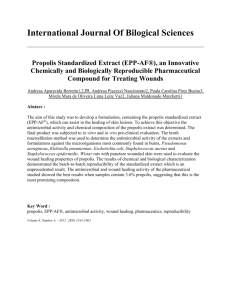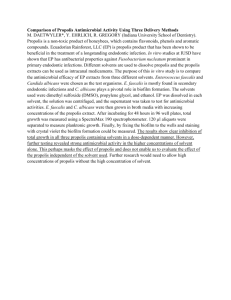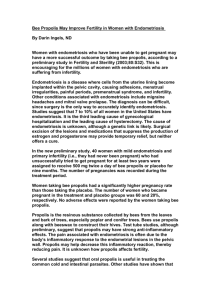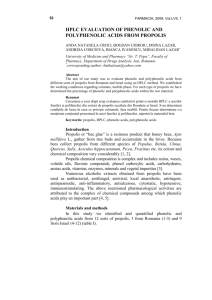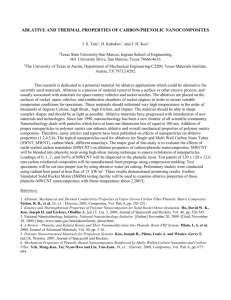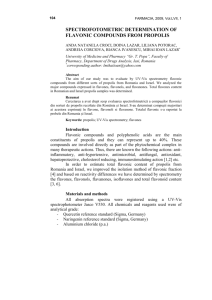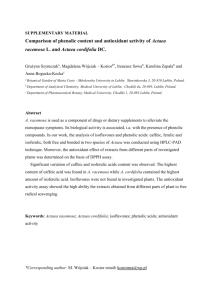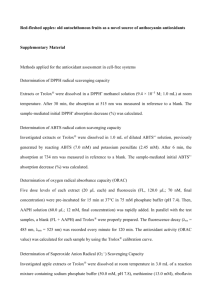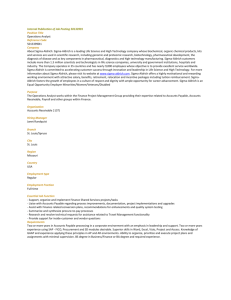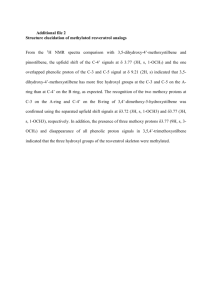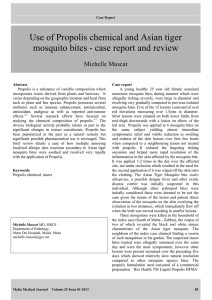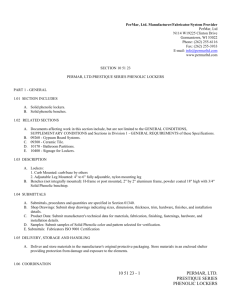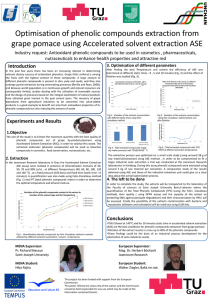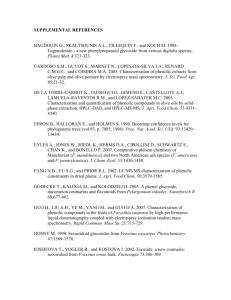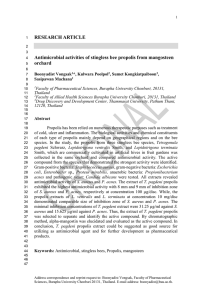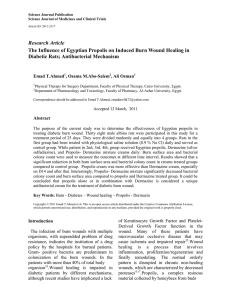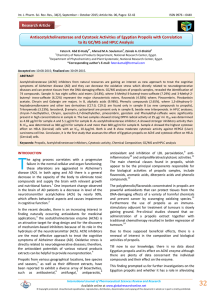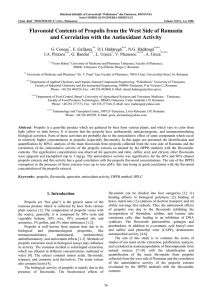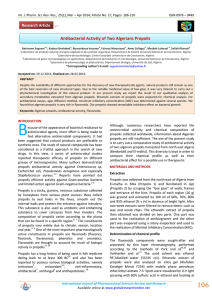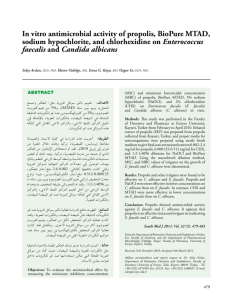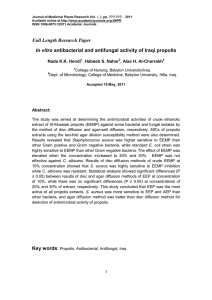SUPPLEMENTARY MATERIAL Phenolic composition and
advertisement
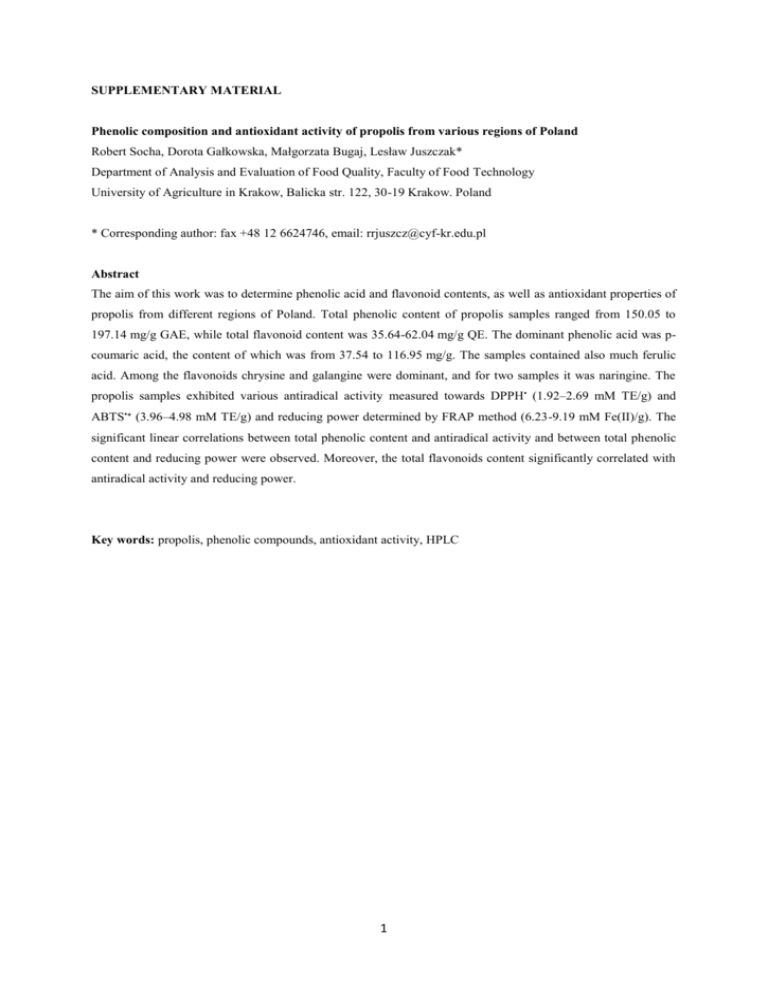
SUPPLEMENTARY MATERIAL Phenolic composition and antioxidant activity of propolis from various regions of Poland Robert Socha, Dorota Gałkowska, Małgorzata Bugaj, Lesław Juszczak* Department of Analysis and Evaluation of Food Quality, Faculty of Food Technology University of Agriculture in Krakow, Balicka str. 122, 30-19 Krakow. Poland * Corresponding author: fax +48 12 6624746, email: rrjuszcz@cyf-kr.edu.pl Abstract The aim of this work was to determine phenolic acid and flavonoid contents, as well as antioxidant properties of propolis from different regions of Poland. Total phenolic content of propolis samples ranged from 150.05 to 197.14 mg/g GAE, while total flavonoid content was 35.64-62.04 mg/g QE. The dominant phenolic acid was pcoumaric acid, the content of which was from 37.54 to 116.95 mg/g. The samples contained also much ferulic acid. Among the flavonoids chrysine and galangine were dominant, and for two samples it was naringine. The propolis samples exhibited various antiradical activity measured towards DPPH• (1.92–2.69 mM TE/g) and ABTS•⁺ (3.96–4.98 mM TE/g) and reducing power determined by FRAP method (6.23-9.19 mM Fe(II)/g). The significant linear correlations between total phenolic content and antiradical activity and between total phenolic content and reducing power were observed. Moreover, the total flavonoids content significantly correlated with antiradical activity and reducing power. Key words: propolis, phenolic compounds, antioxidant activity, HPLC 1 Experimental Materials The crude propolis samples were finely ground and then treated with 95% ethanol, in a ratio of 20 g of sample to 40 g of ethanol. The samples were stored at ambient temperature in the dark for 5 days, with manually stirring once a day. Then the extracts were decanted and collected and the residues were treated with another portion of ethanol for 5 days. All the extracts were combined and centrifuged (3000 g, 30 min.) for purification. Waxes still remaining in the extracts were eliminated by cooling in freezer at -18 ºC for 7 days, centrifuging and filtrating through paper filter. The obtained residues were weighted and the solubilized fractions were determined by weight difference. Then all the extracts were standardized to concentration of 5% (w/w). The samples were prepared in two independent replications. Determination of total phenolic content An aliquot of 0.5 ml of diluted ethanol extract of propolis was mixed with 2.5 ml of 0.2 N solution of FolinCiocalteau reagent (Sigma-Aldrich, Germany), and then 2 ml of sodium carbonate (POCh, Poland) solution (7.5 g/100 ml) was added. Following incubation for 2 hours, absorbance of the reaction mixture was measured at λ = 760 nm against an ethanol blank using a V-630 spectrophotometer (Jasco, Tokyo, Japan). The total phenolic content was expressed as gallic acid equivalent in mg GAE/ g of propolis base on standard curve produced for gallic acid (Sigma-Aldrich, Germany) within the concentration range from 0 to 20 µg/ ml. Determination of total flavonoid content Aliquots of 4 ml of deionised water and 0.3 ml of sodium nitrate(III) (POCh, Poland) solution (15 g/100 ml) were added to 1 ml of diluted ethanol extract of propolis. This was followed by adding of 0.3 ml of aluminium chloride (POCh, Poland) solution (10 g/100 ml) and then 4 ml of sodium hydroxide (POCh, Poland) solution (4 g/100 ml,). The sample was made up to 10 ml with deionised water, stirred and left to stand for 15 min. The total flavonoid content was calculated on the basis of the standard curve for quercetin (Sigma-Aldrich, Germany) solutions in the concentration range from 0 to 50 µg/ ml and expressed as quercetin equivalent in mg QE/ g of propolis. Analysis of phenolic composition by HPLC Chromatographic analyses of phenolic compounds were made with use of high performance liquid chromatography (HPLC – LaChrom, Hitachi, Tokyo, Japan). Hydroxybenzoic acids were identified at λ = 280 nm, hydroxycinnamic acids at λ = 320 nm, while flavonoids at λ = 360 nm. Gradient elution was conducted at a flow rate of 1 ml/min using a solution (2.5 g/100 ml) of acetic acid (POCh, Poland) and acetonitrile (Merck, Germany) as a mobile phase. The solvent system was a linear gradient from 3% of acetonitrile to 40% at 50 min. Finally, the column was eluted isocratically with acetonitrile. The chromatographic separation was carried out on reversed-phase ODS column (250x4,6 μm, particle size 5 μm; Thermo Scientific, USA) at temperature of 30˚C. Quantification of the individual phenolic acids and flavonoids was based on the comparison with standards curves. The chromatographic standards such as chrysin and galangin were purchased from Fluka Chemie AG (Switzerland), the remaining phenolic acids and flavonoids standards were purchased from Sigma-Aldrich (Germany). Prior to the chromatographic analysis, the extracts were diluted and purified by using Millex-LCR syringe filters (PTFE). Determination of antiradical activity 2 An aliquot of 1 ml of diluted ethanol extract of propolis was mixed with 3 ml of 0.1 mM methanol solution of DPPH• (Sigma-Aldrich, Germany). The reaction mixture was vortex-mixed and left in the dark at room temperature for incubation during 30 min. Absorbance was measured at λ = 515 nm against ethanol. The antiradical activity against DPPH• was calculated on the basis of the standard curve for trolox standard solutions in the concentration range from 0 to 0.9 mM and expressed as trolox equivalent in mM TE/ g of propolis. The ABTS•⁺ was obtained in the reaction of a 2 mM stock solution of 2,2’-azino-di(3-ethylbenzothiazoline-6sulfonic acid) diammonium salt (ABTS, Sigma-Aldrich, Germany) in phosphate-buffered with potassium persulfate (POCh, Poland) solution (70 mM). The mixture was left to stand for 24 hours. Prior to analysis, the ABTS•⁺ solution was diluted with phosphate buffer to produce a solution with an absorbance of 0.80 ±0.03 at λ = 734 nm. The 0.1 ml of the appropriately diluted propolis solution was mixed with 6 ml of the ABTS•⁺ cation radical solution and after 15 minutes absorbance was measured at a wavelength of 734 nm. The antiradical activity against ABTS•⁺ was calculated on the basis of the standard curve for trolox standard solutions in the concentration range from 0.0 to 0.9 mM and expressed as trolox equivalent in mM TE/ g of propolis. Determination of reducing power (FRAP) assay Working FRAP reagent was prepared as required by mixing 3.3 ml of acetate buffer (pH 3.6) with 0.33 ml of TPTZ (2,4,6-tripyridyl-S-triazine) (Sigma-Aldrich, Germany) solution in 40 mM HCl and 0.33 mL FeCl 3 (POCh, Poland) solution (20 mM), incubated at 37 °C during 5 min. Then 0.33 ml of the appropriately diluted ethanol extract of propolis was added and the reaction mixture was incubated at 37 °C during 15 min. The absorbance of blue-coloured, ferrous-tripyridyltriazine complex was measured at a wavelength of 593 nm against blank sample. The reducing power was calculated on the basis of the standard curve of aqueous solutions of known ferrous sulphate concentrations in the range of 0 – 1200 µM and expressed in mM Fe(II)/ g of propolis. Statistical analysis For estimation of the significance of differences between the means, a one-way analysis of variance and the test of least significant differences (LSD) at 0.05 probability were applied. Correlations between selected data were calculated using Pearson’s correlation coefficient (r), with Student’s t-test at 0.05 probability. 3 Table S1. Correlations between total phenolic content (TPC) and flavonoid contents (FC) and antiradical activity (DPPH•, ABTS•⁺) and reducing power (FRAP) of propolis samples TPC FC DPPH FC DPPH• ABTS•⁺ 0.6872 • 0.9166 0.7764 ABTS•⁺ 0.6254 0.5886 0.7359 FRAP values 0.7171 0.8580 0.9463 4 0.7562
